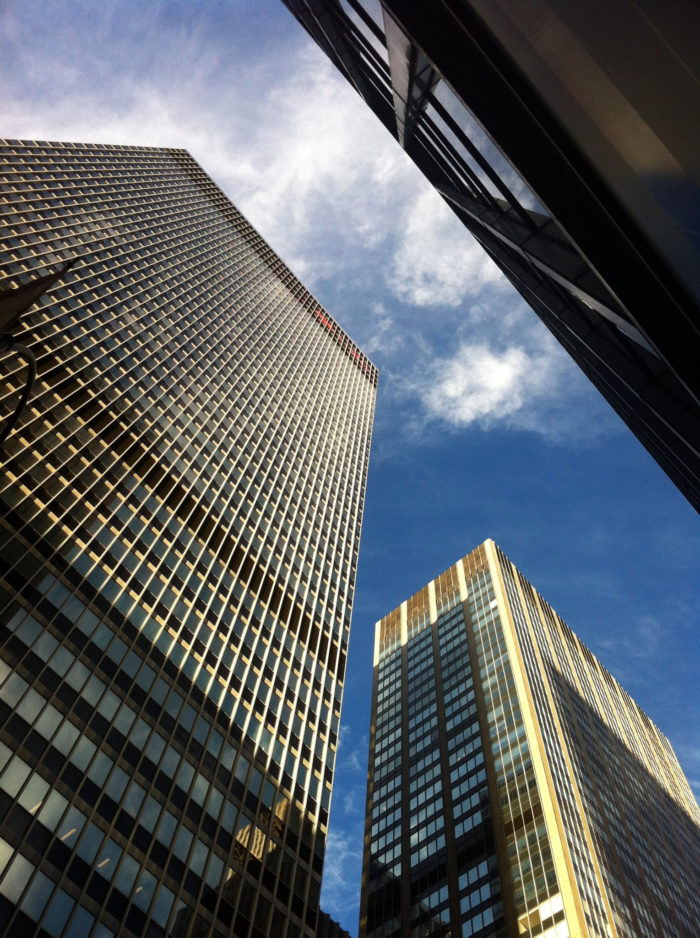New York City Will Require More Efficient Buildings

New York City has embarked on an ambitious program to lower the amount of energy consumed by city-owned buildings and reduce greenhouse gas emissions by 80% by the year 2050.
One measure signed into law by Mayor Bill de Blasio will require most new city-owned buildings, and city-owned buildings undergoing major renovations, to meet the LEED Gold standard. This is a jump from the current requirement for LEED Silver. New buildings also would have to be designed to use half the energy they currently do, according to a statement from Urban Green Council, the local affiliate of the U.S. Green Building Council. Energy use would be based on the median energy use for the building type, or on ASHRAE 90.1 2013, which becomes the city’s new energy code no later than 2017.
The new law requires city-owned buildings to be designed and constructed as “low energy intensity” buildings.
By 2030, the city must have a plan in place to limit energy use in new construction to no more than 38,000 Btu per square foot of floor area per year (Btu per sq. ft. per year) for new construction, and no more than 42,000 Btu per sq. ft. per year for buildings undergoing major renovations, Urban Green said.
Those numbers correspond with Passivhaus Institut targets for new construction and retrofits, according to Ken Levenson, co-president of the North American Passive House Network.
“The bill allows these Passive House targets to be an optional compliance pathway — so it is completely voluntary in the near term,” Levenson explained in an email. “But the law mandates the targets in 2030 — a long way off to be sure. From our perspective the law is good for two reasons: It completely shifts the frame of the discussion. It’s no longer about whether were going to Passive House but how fast. And we think that given the compliance options, when city agencies are looking at the feasibility, Passive House will actually be the economical option and we’ll get uptake completely voluntarily.”
Planners also must consider the possibility of providing at least 10% of the energy the building uses from on-site renewable sources, while projects of three stories or more must consider the feasibility of net-zero energy design.
Urban Green predicts ripple effect
The edict directly affects a relatively small number of buildings, Urban Green noted, but should have a significant ripple effect on privately owned construction as well.
“The impact of this legislation will extend far beyond the city’s vast municipal portfolio, which amounts to 5% of the city’s building stock,” Urban Green said. “New York’s designers and builders will need to create a new generation of hyper-efficient buildings that will ultimately advance building practice in the city’s private sector as well, and have worldwide implications given the international reach of many NYC firms.”
A companion law covers capital projects on city-owned buildings valued at $2 million or more. It updates the LEED requirement from LEED version 3 to version 4, which has more stringent energy requirements, and requires most new projects to meet the LEED Gold standard rather than Silver.
There are new requirements for schools and hospitals, industrial buildings, and factories.
The goal is to lower greenhouse gas emissions
In April, de Blasio announced a number of measures designed to lower energy use and “put the city on a pathway” to an 80% reduction in greenhouse gas emissions by 2050.
There are more than 1 million buildings in New York City, which collectively account for nearly 75% of the city’s total greenhouse gas emissions, according to a statement from the mayor’s office.
De Blasio announced a program called “One City: Built to Last” in September 2014, a 10-year plan to retrofit both public and private buildings. Since then, his office said, the city has worked with a 50-member Buildings Technical Working Group on a “comprehensive analysis” of energy use.
“The results of this analysis allowed the city to identify the best strategic measures to dramatically reduce buildings-based emissions, and will continue to inform integration of these measures into the City’s Energy Code,” the statement said. “The city will phase in the measures over the next 10 years, giving consideration to capital and replacement schedules, in order to minimize costs to building owners.”
The combined efforts are designed to reduce greenhouse gas emissions from buildings a total of 6.1 million metric tons by the year 2025.
Plans announced in April would, according to the mayor’s office:
- Include the development of new measures to improve burner controls for boilers, cover open freezers and refrigerators in retail stores, seal roof vents in elevator shafts, and upgrade exterior lighting.
- Require the owners of large and mid-sized buildings to repair and improve heat distribution systems over the next 10 years with a focus on steam systems and radiators. More than 70% of all large buildings in the city use some form of steam heat.
- Require building owners to consider deep energy retrofits as part of a required energy audit.
Read more: http://www.greenbuildingadvisor.com/blogs/dept/green-building-news%2A#ixzz48wPARRw7
Follow us: @gbadvisor on Twitter | GreenBuildingAdvisor on Facebook
Fine Homebuilding Recommended Products
Fine Homebuilding receives a commission for items purchased through links on this site, including Amazon Associates and other affiliate advertising programs.

8067 All-Weather Flashing Tape

Affordable IR Camera

Handy Heat Gun






















